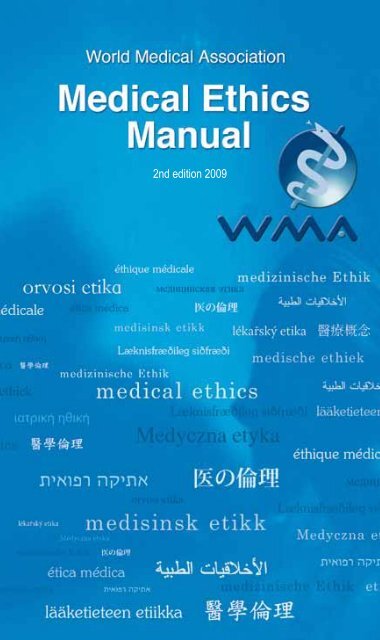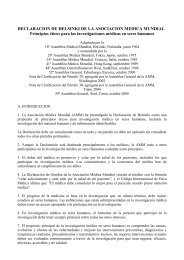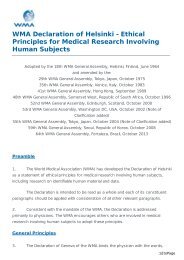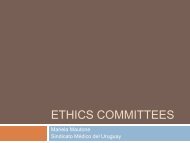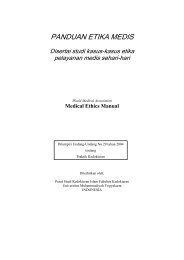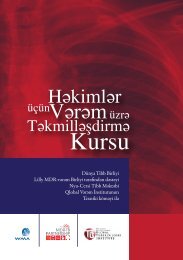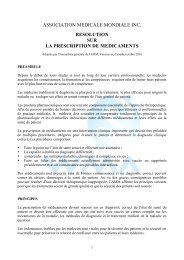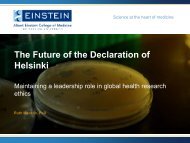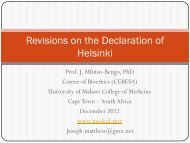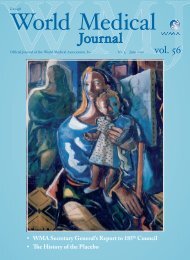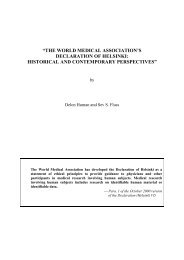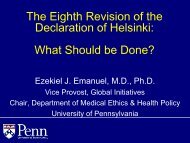Intro - World Medical Association
Intro - World Medical Association
Intro - World Medical Association
- No tags were found...
Create successful ePaper yourself
Turn your PDF publications into a flip-book with our unique Google optimized e-Paper software.
2nd edition 2009
2<strong>Medical</strong> student holding a newborn© Roger Ball/CORBIS
WORLD MEDICAL ASSOCIATION<strong>World</strong> <strong>Medical</strong> <strong>Association</strong><strong>Medical</strong> EthicsManual2nd edition 20091<strong>Medical</strong> Ethics Manual – Principal Features <strong>Medical</strong> of <strong>Medical</strong> Ethics Manual Ethics
2© 2009 by The <strong>World</strong> <strong>Medical</strong> <strong>Association</strong>, Inc.All rights reserved. Up to 10 copies of this document may bemade for your non-commercial personal use, provided thatcredit is given to the original source. You must have prior writtenpermission for any other reproduction, storage in a retrievalsystem or transmission, in any form or by any means. Requestsfor permission should be directed to The <strong>World</strong> <strong>Medical</strong><strong>Association</strong>, B.P. 63, 01212 Ferney-Voltaire Cedex, France;email: wma@wma.net, fax (+33) 450 40 59 37.This Manual is a publication of the Ethics Unit of the <strong>World</strong><strong>Medical</strong> <strong>Association</strong>. It was written by John R. Williams,Director of Ethics, WMA. Its contents do not necessarily reflectthe policies of the WMA, except where this is clearly andexplicitly indicated.Cover, layout and concept by Tuuli Sauren,Inspirit International Communications, Belgium.Production and concept<strong>World</strong> Health Communication Associates, UK.Pictures by Van Parys Media/CORBISCataloguing-in-Publication DataWilliams, John R. (John Reynold), 1942-.<strong>Medical</strong> ethics manual.1. Bioethics 2. Physician-Patient Relations - ethics.3. Physician’s Role 4. Biomedical Research - ethics5. Interprofessional Relations 6. Education, <strong>Medical</strong> - ethics7. Case reports 8. Manuals I. TitleISBN 92-990028-1-9(NLM classification: W 50)
2· Confidentiality· Beginning-of-life issues· End-of-life issues· Back to the case studyChapter Three - Physicians and Society................................62· Objectives· Case study· What’s special about the physician-society relationship?· Dual loyalty· Resource allocation· Public health· Global health· Back to the case studyChapter Four - Physicians and Colleagues..........................80· Objectives· Case study· Challenges to medical authority· Relationships with physician colleagues, teachers andstudents· Reporting unsafe or unethical practices· Relationships with other health professionals· Cooperation· Conflict resolution· Back to the case studyChapter Five - <strong>Medical</strong> Research.................................................94· Objectives· Case study· Importance of medical research· Research in medical practice· Ethical requirements
– Ethics review committee approval– Scientific merit– Social value– Risks and benefits– Informed consent– Confidentiality– Conflict of roles– Honest reporting of results– Whistle blowing– Unresolved issues· Back to the case studyChapter Six - Conclusion................................................................ 112· Responsibilities and privileges of physicians· Responsibilities to oneself· The future of medical ethics3<strong>Medical</strong> Ethics Manual <strong>Medical</strong> – Principal Ethics Manual Features – Table of <strong>Medical</strong> of Contents EthicsAppendix A – Glossary(includes words in italic print in the text).....................................120Appendix B – <strong>Medical</strong> Ethics Resources on the Internet...........123Appendix C – <strong>World</strong> <strong>Medical</strong> <strong>Association</strong>:Resolution on the Inclusion of <strong>Medical</strong> Ethicsand Human Rights in the Curriculum of<strong>Medical</strong> Schools <strong>World</strong>-Wide, and<strong>World</strong> Federation for <strong>Medical</strong> Education:Global Standards for Quality Improvement –Basic <strong>Medical</strong> Education..................................................................125Appendix D – Strengthening Ethics Teaching in<strong>Medical</strong> Schools...................................................................................127Appendix E – Additional Case Studies.............................................129
4ACKNOWLEDGMENTSThe WMA Ethics Unit is profoundly grateful to the followingindividuals for providing extensive and thoughtful comments onearlier drafts of this Manual:Prof. Solly Benatar, University of Cape Town, South AfricaProf. Kenneth Boyd, University of Edinburgh, ScotlandDr. Annette J. Braunack-Mayer, University of Adelaide, AustraliaDr. Robert Carlson, University of Edinburgh, ScotlandMr. Sev Fluss, WMA and CIOMS, Geneva, SwitzerlandProf. Eugenijus Gefenas, University of Vilnius, LithuaniaDr. Delon Human, WMA, Ferney-Voltaire, FranceDr. Girish Bobby Kapur, George Washington University,Washington, DC, USAProf. Nuala Kenny, Dalhousie University, Halifax, CanadaProf. Cheryl Cox Macpherson, St. George’s University, GrenadaMs. Mareike Moeller, Medizinische Hochschule Hannover,GermanyProf. Ferenc Oberfrank, Hungarian Academy of Sciences,Budapest, HungaryMr. Atif Rahman, Khyber <strong>Medical</strong> College, Peshawar, PakistanMr. Mohamed Swailem, Banha Faculty of Medicine, Banha,Egypt, and his ten fellow students who identified vocabulary thatwas not familiar to individuals whose first language is other thanEnglish.The WMA Ethics Unit is supported in part by an unrestrictededucational grant from Johnson & Johnson.
Dr. Delon HumanSecretary General<strong>World</strong> <strong>Medical</strong> <strong>Association</strong>FOREWORDIt is incredible to think that although the founders of medical ethics,such as Hippocrates, published their works more than 2000 yearsago, the medical profession, up until now, has not had a basic,universally used, curriculum for the teaching of medical ethics. Thisfirst WMA Ethics Manual aims to fill that void. What a privilege it isto introduce it to you!The Manual’s origin dates back to the 51st <strong>World</strong> <strong>Medical</strong> Assemblyin 1999. Physicians gathered there, representing medical associationsfrom around the world, decided, “to strongly recommend to <strong>Medical</strong>Schools worldwide that the teaching of <strong>Medical</strong> Ethics and HumanRights be included as an obligatory course in their curricula.” In linewith that decision, a process was started to develop a basic teachingaid on medical ethics for all medical students and physicians thatwould be based on WMA policies, but not be a policy documentitself. This Manual, therefore, is the result of a comprehensive globaldevelopmental and consultative process, guided and coordinatedby the WMA Ethics Unit.5<strong>Medical</strong> Ethics Manual – Principal <strong>Medical</strong> Features Ethics Manual of <strong>Medical</strong> – Foreword EthicsModern healthcare has given rise to extremely complex andmultifaceted ethical dilemmas. All too often physicians areunprepared to manage these competently. This publication isspecifically structured to reinforce and strengthen the ethicalmindset and practice of physicians and provide tools to find ethicalsolutions to these dilemmas. It is not a list of “rights and wrongs”but an attempt to sensitise the conscience of the physician, whichis the basis for all sound and ethical decision-making. To this end,you will find several case studies in the book, which are intended to
6foster individual ethical reflection as well as discussion within teamsettings.As physicians, we know what a privilege it is to be involved in thepatient-physician relationship, a unique relationship which facilitatesan exchange of scientific knowledge and care within a framework ofethics and trust. The Manual is structured to address issues relatedto the different relationships in which physicians are involved, but atthe core will always be the patient-physician relationship. In recenttimes, this relationship has come under pressure due to resourceconstraints and other factors, and this Manual shows the necessityof strengthening this bond through ethical practice.Finally, a word on the centrality of the patient in any discussion onmedical ethics. Most medical associations acknowledge in theirfoundational policies that ethically, the best interests of the individualpatient should be the first consideration in any decision on care. ThisWMA Ethics Manual will only serve its purpose well if it helps preparemedical students and physicians to better navigate through the manyethical challenges we face in our daily practice and find effective waysTO PUT THE PATIENT FIRST.
INTRODUCTIONWhat is medical ethics?Consider the following medical cases, which could have taken placein almost any country:1. Dr. P, an experienced and skilled surgeon, is about to finish nightduty at a medium-sized community hospital. A young woman isbrought to the hospital by her mother, who leaves immediatelyafter telling the intake nurse that she has to look after her otherchildren. The patient is bleeding vaginally and is in a greatdeal of pain. Dr. P examines her and decides that she has hadeither a miscarriage or a self-induced abortion. He does a quickdilatation and curettage and tells the nurse to ask the patientwhether she can afford to stay in the hospital until it is safe forher to be discharged. Dr. Q comes in to replace Dr. P, who goeshome without having spoken to the patient.7<strong>Medical</strong> Ethics Manual – <strong>Medical</strong> Principal Ethics Features Manual of <strong>Medical</strong> – <strong>Intro</strong>duction Ethics2. Dr. S is becoming increasingly frustrated with patients whocome to her either before or after consulting another healthpractitioner for the same ailment. She considers this to be awaste of health resources as well as counter-productive forthe health of the patients. She decides to tell these patientsthat she will no longer treat them if they continue to see otherpractitioners for the same ailment. She intends to approach hernational medical association to lobby the government to preventthis form of misallocation of healthcare resources.3. Dr. C, a newly appointed anaesthetist * in a city hospital, isalarmed by the behaviour of the senior surgeon in the operatingroom. The surgeon uses out-of-date techniques that prolongoperations and result in greater post-operative pain and longerrecovery times. Moreover, he makes frequent crude jokes about*Words written in italics are defined in the glossary (Appendix A).
8the patients that obviously bother the assisting nurses. As a morejunior staff member, Dr. C is reluctant to criticize the surgeonpersonally or to report him to higher authorities. However, hefeels that he must do something to improve the situation.4. Dr. R, a general practitioner in a small rural town, is approachedby a contract research organization (C.R.O.) to participate ina clinical trial of a new non-steroidal anti-inflammatory drug(NSAID) for osteoarthritis. She is offered a sum of money foreach patient that she enrols in the trial. The C.R.O. representativeassures her that the trial has received all the necessaryapprovals, including one from an ethics review committee.Dr. R has never participated in a trial before and is pleasedto have this opportunity, especially with the extra money. Sheaccepts without inquiring further about the scientific or ethicalaspects of the trial.Each of these case studies invites ethical reflection. They raisequestions about physician behaviour and decision-making – notscientific or technical questions such as how to treat diabetes orhow to perform a double bypass, but questions about values, rightsand responsibilities. Physicians face these kinds of questions just asoften as scientific and technical ones.In medical practice, no matter what the specialty or the setting, somequestions are much easier to answer than others. Setting a simplefracture and suturing a simple laceration pose few challenges tophysicians who are accustomed to performing these procedures.At the other end of the spectrum, there can be great uncertaintyor disagreement about how to treat some diseases, even commonones such as tuberculosis and hypertension. Likewise, ethicalquestions in medicine are not all equally challenging. Some arerelatively easy to answer, mainly because there is a well-developedconsensus on the right way to act in the situation (for example, the
physician should always ask for a patient’s consent to serve as aresearch subject). Others are much more difficult, especially thosefor which no consensus has developed or where all the alternativeshave drawbacks (for example, rationing of scarce healthcareresources).So, what exactly is ethics and how does it help physicians deal withsuch questions? Put simply, ethics is the study of morality – carefuland systematic reflection on and analysis of moral decisions andbehaviour, whether past, present or future. Morality is the valuedimension of human decision-making and behaviour. The languageof morality includes nouns such as ‘rights’, ‘responsibilities’ and‘virtues’ and adjectives such as‘good’ and ‘bad’ (or ‘evil’), ‘right’ and‘wrong’, ‘just’ and ‘unjust’. Accordingto these definitions, ethics is primarilya matter of knowing whereas moralityis a matter of doing. Their closerelationship consists in the concernof ethics to provide rational criteria forpeople to decide or behave in someways rather than others.“...ethics is the studyof morality – carefuland systematicreflection on andanalysis of moraldecisions andbehaviour”9<strong>Medical</strong> Ethics Manual – <strong>Medical</strong> Principal Ethics Features Manual of <strong>Medical</strong> – <strong>Intro</strong>duction EthicsSince ethics deals with all aspects of human behaviour anddecision-making, it is a very large and complex field of studywith many branches or subdivisions. The focus of this Manualis medical ethics, the branch of ethics that deals with moralissues in medical practice. <strong>Medical</strong> ethics is closely related, butnot identical to, bioethics (biomedical ethics). Whereas medicalethics focuses primarily on issues arising out of the practice ofmedicine, bioethics is a very broad subject that is concerned withthe moral issues raised by developments in the biological sciencesmore generally. Bioethics also differs from medical ethics insofaras it does not require the acceptance of certain traditional values
10that, as we will see in Chapter Two, are fundamental to medicalethics.As an academic discipline, medical ethics has developed its ownspecialized vocabulary, including many terms that have beenborrowed from philosophy. This Manual does not presuppose anyfamiliarity with philosophy in its readers, and therefore definitions ofkey terms are provided either where they occur in the text or in theglossary at the end of the Manual.Why study medical ethics?“As long as the physician is a knowledgeable and skilful clinician,ethics doesn’t matter.”“Ethics is learned in the family, not in medical school.”“<strong>Medical</strong> ethics is learned by observing how senior physicians act,not from books or lectures.”“Ethics is important, but our curriculum is already too crowded andthere is no room for ethics teaching.”These are some of the common reasons given for not assigningethics a major role in the medical school curriculum. Each of themis partially, but only partially, valid. Increasingly throughout theworld medical schools are realising that they need to provide theirstudents with adequate time and resources for learning ethics. Theyhave received strong encouragement to move in this direction fromorganizations such as the <strong>World</strong> <strong>Medical</strong> <strong>Association</strong> and the <strong>World</strong>Federation for <strong>Medical</strong> Education (cf. Appendix C).The importance of ethics in medical education will become apparentthroughout this Manual. To summarize, ethics is and always hasbeen an essential component of medical practice. Ethical principlessuch as respect for persons, informed consent and confidentialityare basic to the physician-patient relationship. However, the
application of these principles inspecific situations is often problematic,since physicians, patients, their family“The study of ethicsprepares medicalmembers and other healthcare students to recognizedifficult situations andpersonnel may disagree about whatto deal with them in ais the right way to act in a situation.rational and principledThe study of ethics prepares medical manner.”students to recognize difficultsituations and to deal with them in arational and principled manner. Ethicsis also important in physicians’ interactions with society and theircolleagues and for the conduct of medical research.<strong>Medical</strong> Ethics, <strong>Medical</strong>Professionalism, Human Rights and LawAs will be seen in Chapter One, ethics has been an integral partof medicine at least since the time of Hippocrates, the fifth centuryB.C.E. (before the Christian era) Greek physician who is regardedas a founder of medical ethics. From Hippocrates came the conceptof medicine as a profession, whereby physicians make a publicpromise that they will place the interests of their patients above theirown interests (cf. Chapter Three for further explanation). The closerelationship of ethics and professionalism will be evident throughoutthis Manual.In recent times medical ethics has been greatly influenced bydevelopments in human rights. In a pluralistic and multiculturalworld, with many different moral traditions, the major internationalhuman rights agreements can provide a foundation for medicalethics that is acceptable across national and cultural boundaries.Moreover, physicians frequently have to deal with medical problemsresulting from violations of human rights, such as forced migrationand torture. And they are greatly affected by the debate over whether11<strong>Medical</strong> Ethics Manual – <strong>Medical</strong> Principal Ethics Features Manual of <strong>Medical</strong> – <strong>Intro</strong>duction Ethics


